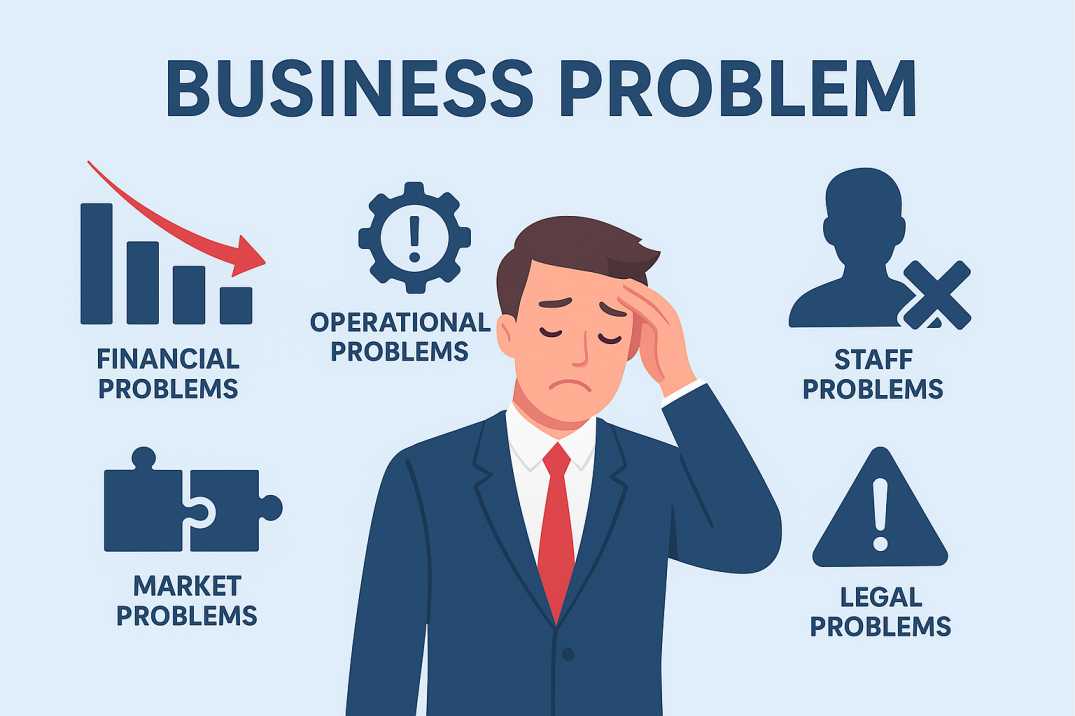16th Sep, 2025| 5 Min read.

What problems generally a business face?
Common Problems Businesses Face
Running a business is never smooth. Every company, whether
small or big, faces challenges. These problems can come from inside the
business (like money, employees, or management) or from outside the
business (like government rules, economy, or competitors).
Here are the main problems explained in detail:
1. Financial Problems (Money-Related Issues)
Money is the lifeline of every business. Without proper cash
flow, even a profitable business can collapse.
- Cash
flow gap – Many businesses sell products/services on credit, but
expenses like rent, salaries, and bills have to be paid immediately. If
customers delay payments, the business suffers.
- Raising
funds – Getting loans from banks can be tough if the company is small
or lacks collateral (assets like land or property). Investors may also
hesitate if financial records are weak.
- Bad
debts – Some customers never pay, which becomes a direct loss.
- Rising
costs – Raw materials, transport, salaries, and electricity bills
often go up, while selling prices may not increase equally.
👉 Example: A
garment shop sells ₹10 lakh worth of clothes on credit in February but
customers pay only in June. In March, April and May, the shop struggles to pay
salaries and rent.
2. Market & Competition Problems
Every business has to deal with changing markets and
competition.
- Too
many competitors – Hard to maintain customers when there are many
options.
- Price
pressure – If a competitor reduces prices, customers may shift,
forcing the business to cut prices and profits.
- Changing
customer preferences – What customers like today may not be in demand
tomorrow (e.g., Nokia mobiles lost market share when smartphones arrived).
- Market
saturation – Sometimes, almost everyone already has the
product/service (e.g., SIM cards, cable TV connections). In such cases,
growth is slow.
👉 Example: A local
cafe struggles when a big coffee chain opens nearby with better offers.
3. Operational Problems (Day-to-Day Work Issues)
Operations mean how the business runs every day. Problems
here directly affect efficiency.
- Inefficient
processes – Using outdated methods or manual work increases costs and
delays.
- Supply
chain issues – Raw materials may arrive late or be too expensive.
- Over-dependence
– Relying only on one supplier or one big customer is risky. If they stop,
the business may collapse.
- Technology
gap – If the business doesn’t adopt modern technology (like digital
payments or online sales), it loses out to competitors.
👉 Example: A small
manufacturer cannot deliver on time because raw material from China is delayed,
so clients shift to another supplier.
4. Human Resource Problems (People Issues)
Employees are the backbone of a company, but managing them
is tough.
- Hiring
skilled workers – Talented employees prefer bigger companies with
higher pay.
- High
turnover – Employees leave for better salaries, creating instability.
- Low
productivity – Untrained or unmotivated workers slow down business.
- Conflicts
– Disagreements between staff or with management hurt teamwork.
👉 Example: A
software startup loses its best developers to bigger IT companies, delaying
projects and losing clients.
5. Legal & Compliance Problems (Rules &
Regulations)
Businesses must follow government laws, but frequent changes
create problems.
- Changing
rules and regulations– Tax laws, GST rates, labour laws, or
industry policies may change suddenly.
- Penalties
& Fines – Late filing of GST or ROC returns results in fines.
- Intellectual
property theft – Competitors may copy your product, logo, or design.
- Licensing
issues – Missing permits can shut down operations.
👉 Example: A
restaurant runs without a proper food license (FSSAI). Authorities raid and
close it, causing huge loss.
6. Management & Strategy Problems
Bad management decisions often create bigger troubles.
- No
clear vision – Businesses fail if they don’t know their long-term
goal.
- Poor
planning – Spending too much money on the wrong things.
- Resistance
to change – Sticking to old ways when the market is changing fast.
- Dependence
on one person – If the founder or one key manager leaves, the business
struggles.
👉 Example: Kodak
ignored digital cameras and focused only on film cameras, which ruined the
company.
7. External Problems (Outside Control)
Some problems are not in the business’s control but still
affect it.
- Economic
slowdown – People spend less during recession, so sales fall.
- Inflation
– Prices of materials rise, reducing profit margins.
- Government
policies – New taxes, import/export restrictions, or bans can hurt
industries.
- Natural
disasters / pandemics – Events like floods, earthquakes, or Covid-19
can suddenly stop business operations.
👉 Example: During
Covid-19, gyms, theatres, and travel businesses faced total shutdowns.
And there are other problems time to time they occur. Because
of these problems sometime a business try to quit and then BizzXchange
helps in solving these problems